
The pancake batfish, Atlantic pancake batfish, Louisiana pancake batfish or spiny batfish, is a species of marine ray-finned fish belonging to the family Ogcocephalidae, the deep sea batfishes or seabats. This species is found in the Western Atlantic Ocean.

Ogcocephalidae is a family of anglerfish specifically adapted for a benthic lifestyle of crawling about on the seafloor. Ogcocephalid anglerfish are sometimes referred to as batfishes, deep-sea batfishes, handfishes, and seabats. They are found in tropical and subtropical oceans worldwide. They are mostly found at depths between 200 and 3,000 m, but have been recorded as deep as 4,000 m (13,000 ft). A few species live in much shallower coastal waters and, exceptionally, may enter river estuaries.

Frogfishes are any member of the anglerfish family Antennariidae, of the order Lophiiformes. Antennariids are known as anglerfish in Australia, where the term "frogfish" refers to members of the unrelated family Batrachoididae. Frogfishes are found in almost all tropical and subtropical oceans and seas around the world, the primary exception being the Mediterranean Sea.

The spotfin frogfish, also known as the big-spot angler, coin-bearing frogfish, darkspot frogfish, ocellated angler, ocellated fringed fishing frog, opulent frogfish, spotfin angler or white-finger anglerfish, is a species ray-finned fish belonging to the family Antennariidae, the frogfishes. The spotfin frogfish is found in scattered locations the eastern Atlantic, Indian and western Pacific Oceans.

The pink frogmouth, or redeye, pink gaper or uniform gaper, is a species of marine ray-finned fish belonging to the family Chaunacidae, the sea toads. This species is found in the Atlantic Ocean.

Glauert's anglerfish is species of marine ray-finned fish belonging to the subfamily Histiophryninae in the family Antennariidae, the frogfishes. This species is the only species in the monospecific genus Allenichthys. This species is endemic to southern Australia.

The redeye gaper, Chaunax stigmaeus, is a sedentary species of anglerfish in the family Chaunacidae. It is native to deep waters in the western North Atlantic from the Georges Bank off New England southward to the Blake Plateau off South Carolina. The species is found on the outer continental shelf and upper continental slope at a depth of 90–730 m and among dense beds of dead coral rubble, their preferred habitat. The original type specimen was caught in a trawl off Atlantic City on March 1, 1946, and donated to the Academy of Natural Sciences by Carroll B. Atkinson. The name stigmaeus means "speckled" in Greek. This species is a member of the C. pictus species complex.

Histiophryne is a genus of marine ray-finned fishes belonging to the subfamily Histiophryninae in the family Antennariidae, the frogfishes. These fishes are found in waters ranging from Taiwan to South Australia. There are currently five known species. These fishes are easily distinguished from other anglerfishes as having a reduced luring appendage, a highly evolved form of the first dorsal fin spine.

Chaunax, variously known as coffinfishes, gapers or frogmouths, is a genus of marine ray-finned fishes, it is one of two genera belonging to the family Chaunacidae, the sea toads. They are found in tropical and subtropical oceans around the world typically in deep water.
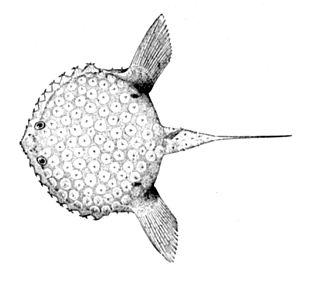
Halieutichthys is a genus of marine ray-finned fishes belonging to the family Ogcocephalidae, the deep-sea batfishes or sea bats. The fishes in this genus are found in the western Atlantic Ocean.
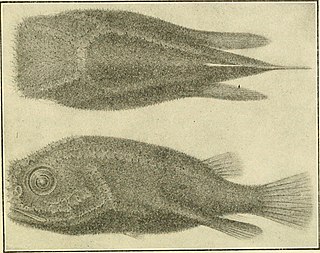
Coelophrys is a genus of marine ray-finned fishes belonging to the family Ogcocephalidae, the deep-sea batfishes or sea bats. The fishes in this genus are found in the western Pacific Ocean and the Indian Ocean.

Antennarius is a genus of anglerfish belonging to the family Antennariidae, the frogfishes. The fishes in this genus are found in warmer parts of the Atlantic, Indian and Pacific Oceans.

Chaunacops is a genus of marine ray-finned fishes belonging to the family Chaunacidae, the sea toads. This genus of deep-sea anglerfishes contains 4 species and these are found in the Indo-West Pacific. southeastern Pacific and Western Atlantic oceans. Little is known about the life history and biology of these fishes.
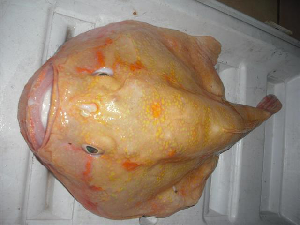
The furry coffinfish, also sometimes referred to the coffinfish, is a species of marine ray-finned fish belonging to the family Chaunacidae, the sea toads. It is found in salty temperate waters of southwestern Pacific, off east coast of Australia.

The Atlantic batfish is a species of marine ray-finned fish belonging to the family Ogcocephalidae, the deep-sea batfishes. It is found in deep water in the Atlantic Ocean where it lives on the seabed, feeding on small invertebrates.
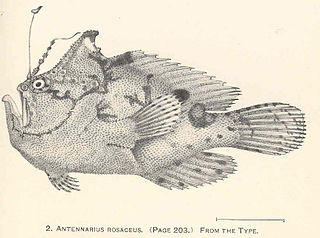
Abantennarius rosaceus, the rosy frogfish, rosy anglerfish, pink anglerfish or spiny tufted frogfish, is a species of marine ray-finned fish belonging to the family Antennariidae, the frogfishes. The rosy frogfish is found in the Indo-Pacific region.
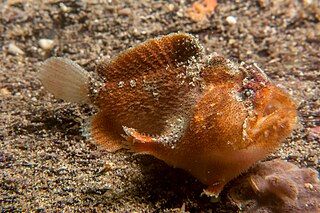
Echinophryne crassispina, the prickly anglerfish, prickly frogfish or thick-spined anglerfish, is a species of marine ray-finned fish belonging to the subfamily Histiophryninae in the family Antennariidae, the frogfishes. These fishes are endemic to the temperate waters of southern Australia.

Antennarius scaber, the splitlure frogfish or strated frogfish, is a species of marine ray-finned fish belonging to the family Antennariidae, the frogfishes. This species is found in the Western Atlantic Ocean and was previously considered to be a synonym of Antennarius striatus.

Chaunax suttkissi, the pale-cavity gaper, spotted frogmouth, spotted gaper or Sutkus sea toad, is a species of marine ray-finned fish belonging to the family Chaunacidae, the sea toads. This species is found in the Atlantic Ocean.
Dibranchus tremendus is a species of marine ray-finned fish belonging to the family Ogcocephalidae, the deep-sea batfishes. It is found in deep water in the Atlantic Ocean. This species was identified as a different species from Dibranchus atlanticus in 1999. It is the largest species in its genus.




















